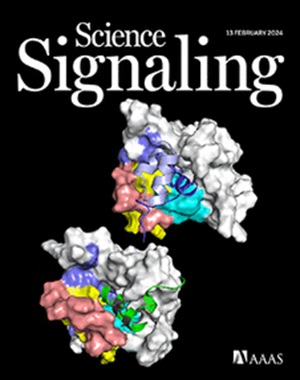腺苷2A受体依赖性激活AMPK通过表观遗传和代谢重编程抑制TH17细胞致病性
IF 6.6
1区 生物学
Q1 BIOCHEMISTRY & MOLECULAR BIOLOGY
引用次数: 0
摘要
代谢重编程控制保护性和致病性T辅助17 (TH17)细胞反应。当naïve T细胞在体外分化为TH17细胞时,细胞因子激活素A的存在促进其成熟到非致病性状态。在这里,我们发现激活素A诱导的非致病性TH17细胞表现出有氧糖酵解减少和氧化磷酸化(OXPHOS)增加。在多发性硬化症小鼠模型中,通过腺苷A2A受体(A2AR)和amp激活的蛋白激酶(AMPK)的信号传导增强OXPHOS,并将致病性TH17细胞重编程为非致病性状态,而不诱导中枢神经系统自身免疫。在致病性TH17细胞中,转录辅激活因子p300/ cbp相关因子(PCAF)增加了参与有氧糖酵解和TH17致病程序的基因的组蛋白3lys9 (H3K9ac)的乙酰化。相反,在非致病性激活素a处理的TH17细胞中,AMPK信号抑制了pcaf介导的参与有氧代谢的基因的H3K9ac修饰,增强了参与OXPHOS和非致病性TH17程序的基因的H3K9ac修饰。总之,我们的研究结果揭示了A2AR-AMPK信号作为抑制TH17细胞致病性的中心代谢检查点。本文章由计算机程序翻译,如有差异,请以英文原文为准。
Adenosine 2A receptor–dependent activation of AMPK represses TH17 cell pathogenicity through epigenetic and metabolic reprogramming
Metabolic reprogramming controls protective and pathogenic T helper 17 (TH17) cell responses. When naïve T cells are differentiated into TH17 cells in vitro, the presence of the cytokine activin A promotes their maturation into a nonpathogenic state. Here, we found that nonpathogenic TH17 cells induced by activin A displayed reduced aerobic glycolysis and increased oxidative phosphorylation (OXPHOS). In response to activin A, signaling through the adenosine A2A receptor (A2AR) and AMP-activated protein kinase (AMPK) enhanced OXPHOS and reprogrammed pathogenic TH17 cells toward nonpathogenic states that did not induce central nervous system autoimmunity in a mouse model of multiple sclerosis. In pathogenic TH17 cells, the transcriptional coactivator p300/CBP-associated factor (PCAF) increased acetylation at histone 3 Lys9 (H3K9ac) of genes involved in aerobic glycolysis and TH17 pathogenic programs. In contrast, in nonpathogenic activin A–treated TH17 cells, AMPK signaling suppressed PCAF-mediated H3K9ac modification of genes involved in aerobic metabolism and enhanced H3K9ac modification of genes involved in OXPHOS and nonpathogenic TH17 programs. Together, our findings uncover A2AR-AMPK signaling as a central metabolic checkpoint that suppresses TH17 cell pathogenicity.
求助全文
通过发布文献求助,成功后即可免费获取论文全文。
去求助
来源期刊

Science Signaling
BIOCHEMISTRY & MOLECULAR BIOLOGY-CELL BIOLOGY
CiteScore
9.50
自引率
0.00%
发文量
148
审稿时长
3-8 weeks
期刊介绍:
"Science Signaling" is a reputable, peer-reviewed journal dedicated to the exploration of cell communication mechanisms, offering a comprehensive view of the intricate processes that govern cellular regulation. This journal, published weekly online by the American Association for the Advancement of Science (AAAS), is a go-to resource for the latest research in cell signaling and its various facets.
The journal's scope encompasses a broad range of topics, including the study of signaling networks, synthetic biology, systems biology, and the application of these findings in drug discovery. It also delves into the computational and modeling aspects of regulatory pathways, providing insights into how cells communicate and respond to their environment.
In addition to publishing full-length articles that report on groundbreaking research, "Science Signaling" also features reviews that synthesize current knowledge in the field, focus articles that highlight specific areas of interest, and editor-written highlights that draw attention to particularly significant studies. This mix of content ensures that the journal serves as a valuable resource for both researchers and professionals looking to stay abreast of the latest advancements in cell communication science.
 求助内容:
求助内容: 应助结果提醒方式:
应助结果提醒方式:


